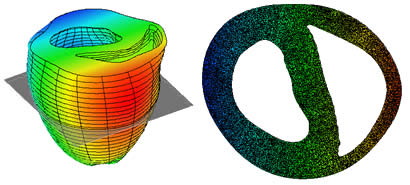Sudden death is the most catastrophic manifestation of heart disease. Many patients who die do so because they develop a lethal arrhythmia: ventricular fibrillation (VF). Prediction of sudden death, and hence appropriate treatment, is hampered by our failure to understand the basic mechanisms that cause VF to arise in a particular patient at a particular instant. The goal of this research is to understand and prevent sudden death by the appropriate use of clinical, biological and bioengineering techniques.
 It has been established
that the occurrence of arrhythmia is associated with a delay in conduction
through the heart muscle. This type of change can now be effectively analysed
using new signal processing methods, and the results incorporated into extended
models of the heart muscle made using the latest developments in computational
fluid dynamics. An understanding of the relationship between measurements that
are made in patients and the disease process in their heart muscle will aid
identification of patients at high risk of sudden death.
It has been established
that the occurrence of arrhythmia is associated with a delay in conduction
through the heart muscle. This type of change can now be effectively analysed
using new signal processing methods, and the results incorporated into extended
models of the heart muscle made using the latest developments in computational
fluid dynamics. An understanding of the relationship between measurements that
are made in patients and the disease process in their heart muscle will aid
identification of patients at high risk of sudden death.
A group of researchers from CUED will be applying their expertise to this problem in the areas of signal processing methods (Dr Bill Fitzgerald, Dr Joan Lasenby), Computational Fluid Dynamics (Professor Bill Dawes, Dr Mark Savill) dynamic loading of structures (Dr Chris Burgoyne, Professor David Newland) and Dr Peter Long (Design Engineer) . This work is being carried out in conjunction with the Biochemistry department (Dr A Grace) using multi-electrode (500+) recordings in the isolated mammalian heart. This research has already shown striking similarities between data obtained from patients and that from pharmacological and genetically modified animal models of heart disease.
Research has concentrated on the experimental study of patients who are at risk of sudden death which is due to a fatal arrhythmia, Ventricular Fibrillation (VF). This has lead to a clinical database of over 650 patients with a variety of diseases including 85 who have suffered VF. A number of patients who appear at high risk of sudden cadiac death (SCD) received implatable de-fibrillators (ICDs). Some of these patients subsequently developed VF and their lives were saved by the ICD.
 |
| A mesh generated from rabbit heart geometry. |
This success has lead to two other strands of experimental work in order to understand the mechanisms of SCD. The first is experimental work on modelling some human diseases. This has built a strong bridge between engineering and the life sciences. The second strand is the mathematical modelling of activation within the heart to understand the relationship between what is measured in man and the likelihood of VF. Preliminary work has shown that some clinical measurements can be modelled with surprising accuracy.
Clinical links with Papworth Hospital will be provided by Dr Richard Saumarez, who will also facilitate clinical trials.
This research is being funded by The British Heart Foundation, the EPSRC and the Medical Research Council.